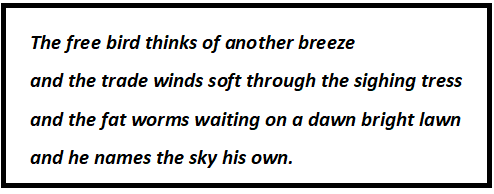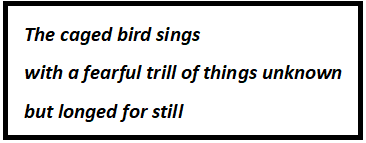Hi Everyone!! This article will share Caged Bird Questions & Answers.
Written by Maya Angelou, this poem illustrates the differences between African Americans and the Whites during the civil rights era.
In my previous posts, I have shared the questions & answers of The Luncheon, Merchant of Venice and The Model Millionaire so, you can check these posts as well.
Caged Bird Questions & Answers
Question 1: Why does the caged bird open his throat to sing?
Answer: The caged bird opened his throat to sing because his wings are clipped and feet are tied.
Question 2: What do the words ‘dares to claim the sky’ mean?
Answer: The words ‘dares to claim the sky’ means that the free bird enjoys the freedom to fly as high as he can and even claims the sky as his own.
Question 3: Quote the line that shows the caged bird has lost the will to survive.
Answer: The line that shows that the caged bird has lost the will to survive is, “But a caged bird stands on the grave of dreams”.
Question 4: Name three things the free bird thinks of.
Answer: The free bird thinks of another breeze, the trade winds through the sighing trees and the fat worms waiting on a bright lawn at the dawn.
Question 5: What does the poet wish to imply by the lines ‘a free bird leaps on the wind and floats downstream’?
Answer: With reference to the above-mentioned lines, the poet wishes to imply that the free bird is ready and quickly takes the flight with the passing wind. It is free to fly with the wind and even float downstream as its wings are not clipped and feet not tied like that of a caged bird.
Question 6: The poet says that the caged bird sings with ‘fearful trill’. Why do you think she uses the word ‘fearful’ here?
Answer: The caged bird sings with ‘fearful trill’. The poet has used the word ‘fearful’ to depict the mindset of the caged bird, as he is apprehensive about the unknown dangers. He has lost his confidence after being confined to the cage and is afraid of anything wrong that might happen to him.
Caged Bird Questions & Answers
Question 7: Where is the song of the caged bird heard? What does he sing of?
Answer: The song of the caged bird is heard on distant hill and he sings of freedom and longs for calmness.
Question 8: How does the poet contrast the free bird and the caged bird?
Or
Write a character sketch of a free bird and a caged bird.
Answer: The poet shows a contrast of free bird and the caged bird through various images. The free bird readily takes the flight with passing winds and floats downstream till the end of the currents and then again fly high in the sky into the beautiful orange rays of sun and even claims the sky of his own. However, the caged bird is confined to his narrow cage and can barely see beyond the bars of his cage. His wings are clipped and feet are tied. He is bound and helpless to do anything, hence can only sing through his throat that too with a fearful voice, as he is afraid of any unknown danger or anything wrong that might happen to him. His song of freedom is heard on a distant hill and he longs for serenity and calmness. The free bird on the other hand thinks of another breeze, trade winds passing through sighing trees and the fat worms waiting on a lawn at the dawn, whereas the caged bird has nothing to look forward as his dreams are gone, they are dead and he stands on the grave of his dreams.
Question 9: What effect do you think rhyme and repetition have in this poem?
Answer: There is no specific rhyme scheme in the poem. The entire poem shows the contrast between the free bird and the caged through various images shown by the poet. We can see few rhyming words like cage, rage, trill, still and hill, however they are not in a set pattern. The last stanza is the repetition of the third stanza and this repetition draws readers’ attention to the plight of the caged bird which has been clearly portrayed by the poet.
Question 10: Read these lines and answer the questions:

(a) Why does the free bird think of ‘another breeze’?
Answer: The free bird thinks of ‘another breeze’ as it has the freedom to explore and is ready to take any risks as it is not bound by restrictions.
(b) What do the words ‘fat worms’ signify?
Answer: The fat worms signify good and coveted opportunities that the free bird can enjoy, which the caged bird is deprived of.
(c) What do you understand by the words ‘he names the sky his own’?
Answer: These words means that the free bird has got the beautiful gift of freedom, which has made him so confident that he can fulfil his desire to fly high in the sky and can even claim the sky as his own.
Caged Bird Questions & Answers
Question 11: Read these lines and answer the questions:

(a) What are the conditions in which caged bird lives?
Answer: The caged bird is confined to a cage, with his wings clipped and feet tied. He is bound and helpless to do anything, hence can only sing through his throat that too with a fearful voice.
(b) Why do you think the poet presents the free bird before depicting the caged bird?
Answer: The poet presents the free bird before depicting the caged bird to portray the contrast between the two birds very clearly. The poet has first shown the gift of freedom and the happiness that the free bird enjoys, so that the readers can understand the pain and sorrow of the caged bird.
(c) What can the caged bird be a symbol of? Justify your answer.
Answer: The caged bird symbolizes African American who were deprived of basic right and were target of racial discrimination during the civil rights era. They had to live by certain rules that were imposed on them and had to suffer as they were not free to dream, explore and achieve what they wanted.
Question 12: What does the free bird do while flying in the free air?
Answer: The free bird readily takes the flight with passing winds and floats downstream till the end of the currents and then again fly high in the sky into the beautiful orange rays of sun and even claims the sky of his own.
Question 13: How does the caged bird pass its time in the cage?
Answer: The caged bird sings the song of freedom with a fearful voice in the cage.
Question 14: What does the poet mean by ‘clipped wings’ and ‘tied feet’?
Answer: Both ‘clipped wings’ and ‘tied feet’ are used as metaphor by the poet. Both the metaphors here mean bondage or immobility or deprived of independence or freedom. It symbolizes the hardships experienced by African American through the hands of whites during the civil rights era.
Question 15: The poet has used powerful metaphors in this poem. What is meant by these two metaphors?
(a) Bars of rage
Answer: ‘Bars of rage’ are the restrictions that has led the bird to confinement of cage. The bird is frustrated and full of anger, which depicts the anger of the African American who were deprived of their basic rights and were confined to restrictions or rules imposed on them as a part of racial discrimination.
(b) Grave of dreams
Answer: ‘Grave of dreams’ refer to the dreams that one saw and wanted to explore and achieve are now dead and buried by the society as a result of discrimination. The bird or the people who are referred to here as African American are standing on the graves of their dead dreams as they know that these dreams will never come true.
So, these were Caged Bird Questions & Answers.